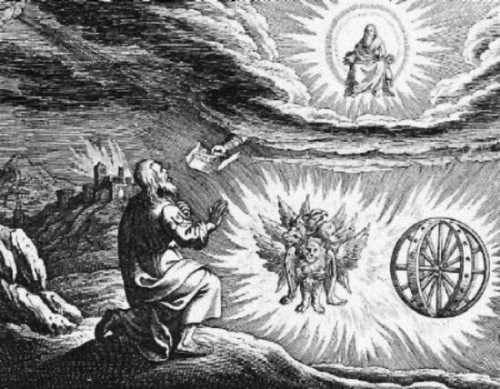4. UFO Books
Led by the genius poet-investigator, Charles Fort (1874-1932), who for about 40 years assiduously gathered reports of “strange phenomena” from scientific journals and news media, the ufologists have ferreted out and compiled many hundreds of reports of “UFOs” that were seen before the age of aviation and rocketry.
The use of selected UFO books — with frequent spot checks of their sources and veracity — serves a double purpose. It enables us to read the “ancient reports” in them and — this is nearly as important — it permits us to see what the modern ufologist selects from the past and how he utilizes and interprets the evidence he has compiled.
Such compilations pose some serious problems for the reader not already convinced of the existence of UFOs. They inflict mental fatigue and anxiety after the reading of each “report” because one is inevitably led into the same brain-numbing round of unanswered questions: Does the alleged book or manuscript in which the report was found really exist?
Where is it? Did the writer actually see the original document or is he quoting a secondary source? Is the version presented here a faithful copy of the original or an accurate translation? Is the ”report” in question a factual honest report of something actually seen, or is it a poetic, metaphorical, religious, symbolical, mythical, political, fabrication made legitimately within its own social context, but one that is no longer viable or meaningful to us now? If the “strange phenomenon” was actually seen, then, we ask: “Was this “light,” or fiery sphere,” “wheel of fire,” or “flaming cross,” or “cigar-shaped object” or ”saucer” or ”disk” seen by reliable witnesses?
How reliable is the judge of their reliability? What did they actually see? Where did it come from? What was it made of? Who, if anyone or anything, was in it? And so forth, far, far, into the night. Inconclusiveness, the mental plague of ufology, invariably cancels out or suspends in mid-air the great majority of the fascinating reports and leaves the reader (this reader for sure) quite frustrated and disappointed.
It soon becomes clear that it would take years of full-time research to track down and verify the thousands of “ancient‘ reports included in the nearly 1600 books and articles about UFOs. This means, then, that the general reader, who rarely ever bothers to verify what he reads, is merely given the option to trust or distrust the scholarly accuracy and motivations of the writers who offer him the impressive-looking lists of UFOs sightings.
This becomes a very narrow choice indeed: one that is negotiable only in the arena of speculation provided by the writers who believe in UFOs. And, since to my knowledge, no one has written an impartial or objective book about ancient “UFO reports,” the nature of the dialogue between a UFO author and his reader becomes that of a man convinced of the existence of UFOs and a reader whom he hopes to convert to his belief.
The strategy for UFO proselytizing is predictable. In book after book, the reader is assured that UFOs are not a sudden, modern manifestation but that there have been numerous reports of similar visitations “down through the ages.” The author then proceeds to list the most impressive and authoritative-sounding of the “ancient UFO reports,” stressing those that most closely resemble modern accounts of “spacecraft sightings.
He also seeks to create an aura of believability and respectability for UFO phenomena by quoting and re-interpreting “UPO reports from the Holy Bible,” from ancient Roman authors like Pliny The Elder, from Shakespeare, from Hindu religious texts, from “ancient manuscripts found in monasteries,” or as in one notable example, from a “papyrus manuscript found among the papers of the late Professor Alberto Tulli, former director of the Vatican Egyptian Museum.”
This is a legitimate procedure, of course, and we know that many important scholarly discoveries have been made in church archives, (to take that example) because in many periods in history, the church did chronicle and preserve records of important events. But the presentation of such prestigious ecclesiastical material is used in UFO literature in order to bestow an aura of sanctity upon all UFOs, ancient and modern; i.e., to make them respectable by association.
Thus, for example, The Flying Saucer Reader, edited by Jay David (1967) self-described as “an anthology of the best and most authoritative (1968) of the incredible but undeniable phenomenon of UFOs,” begins with “evidence” from Biblical times; and a chapter is written by Paul Thomas in (1965) in which he declares that the famous “miracle of Fatima, Portugal” (13 October 1917) was actually a flying saucer that was mistakenly identified as the Virgin Mary. The book also includes excerpts from two books in which the authors describe their fluent communications with “extra-terrestrial beings” with the aid of (1) an ouija board using a pencil taped to a water glass, and (2) “mental telepathy.”
For the true-believing ufologist, the Holy Bible is a veritable treasure-trove of sacred and profane UFOs. In Chapter 13, verse 21 of the Book of Exodus, “. . . the Lord went before them by day in a pillar of fire, to give them light; to go by day and night.” (Ufologist regard this as evidence that God sent a spaceship to guide the Israelites during their 40-year journey to the Holy Land.
The image from Exodus is repeated in the New Testament in the “Star of Bethlehem“: According to St. Matthew, (2,9) “and, lo, the star, which they saw in the East, went before them, till it came and stood where the young child was.” Though not regarded as a UFO, but a “star,” it also behaved like some UFOs that start and stop.
There are, also, many “fiery chariots,” “angels with wings,” and “cherubim” in the New and Old Testaments, all of which have been claimed by the occultist’s modern ufologists as UFOs.
